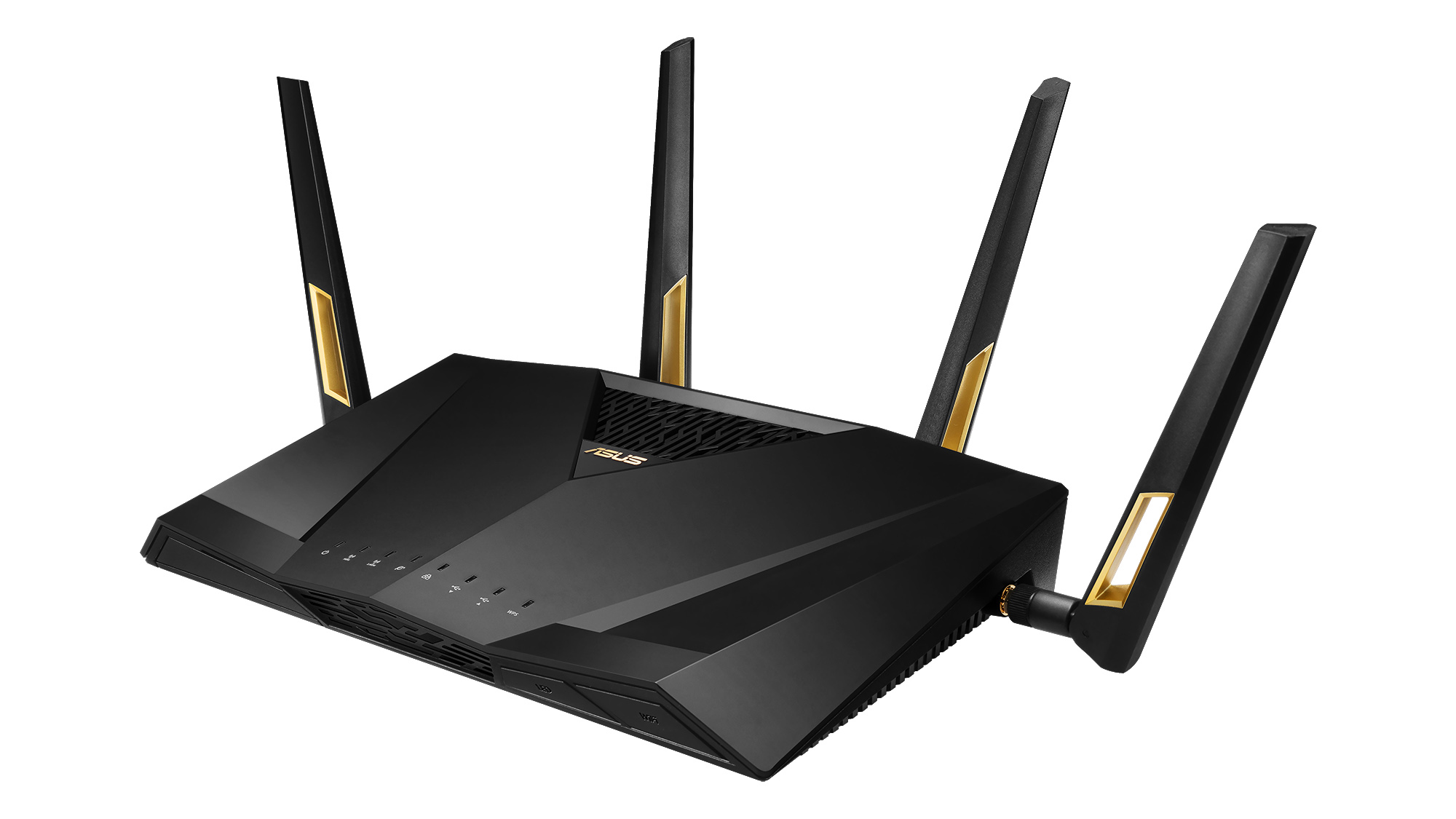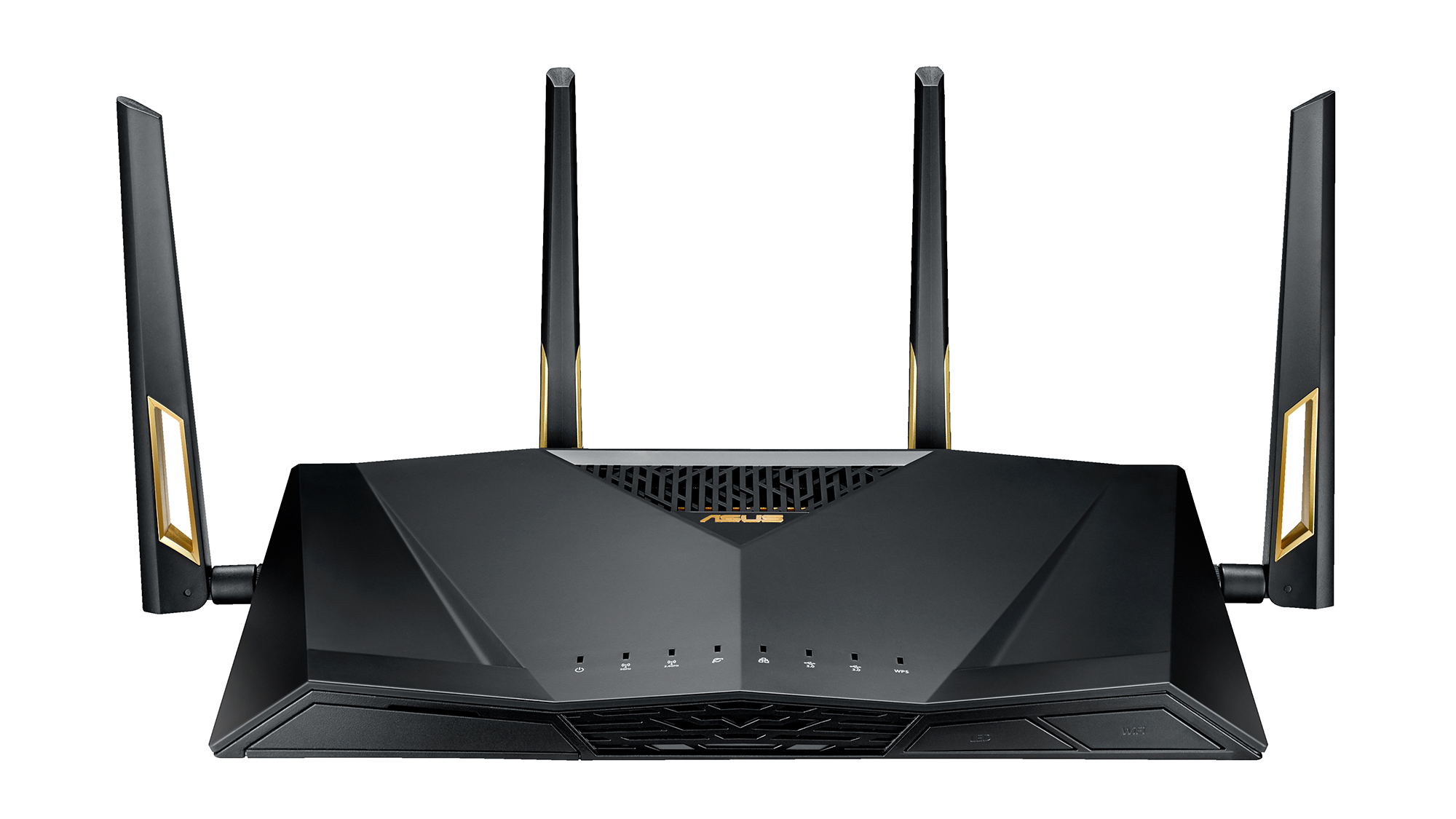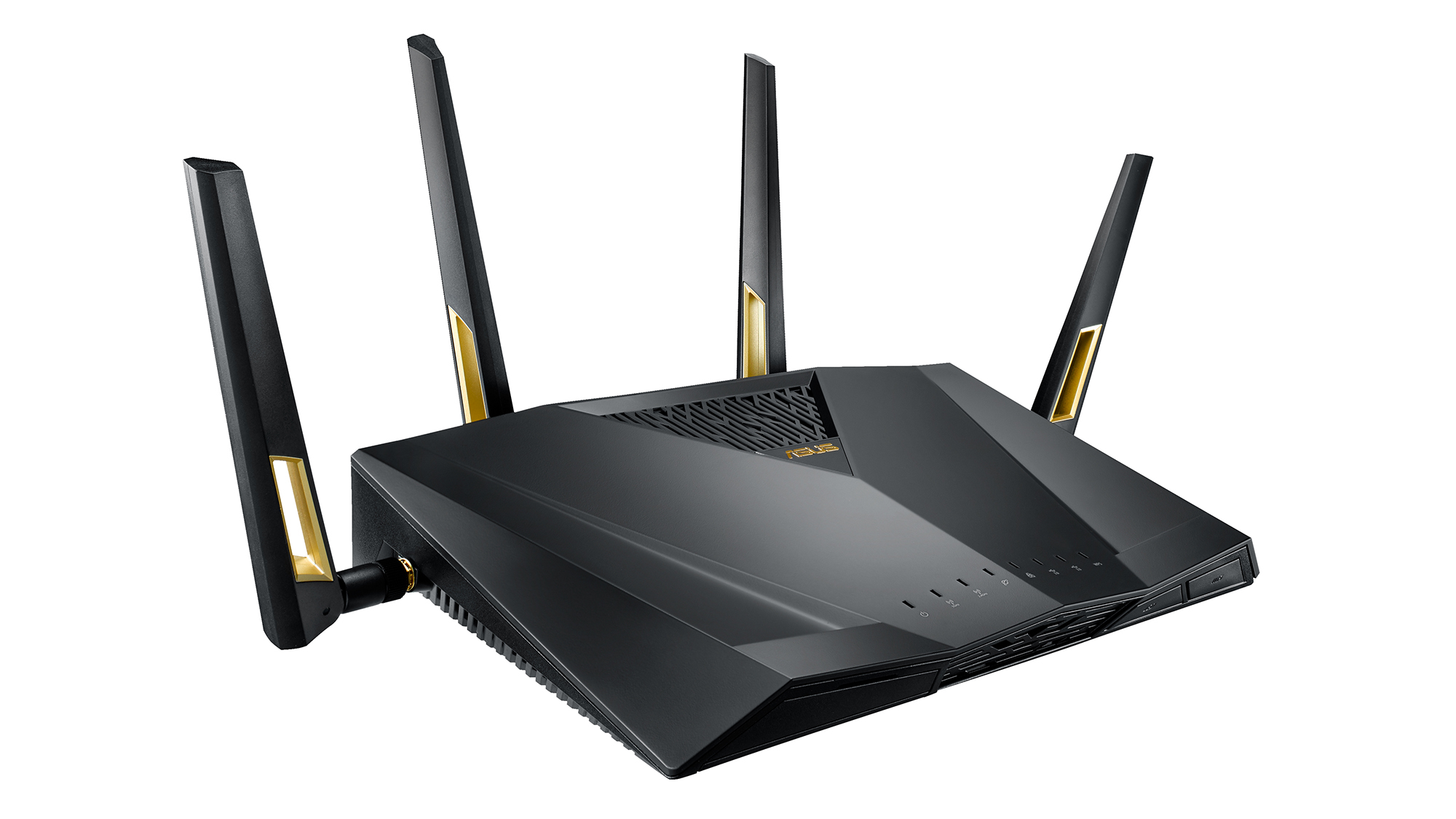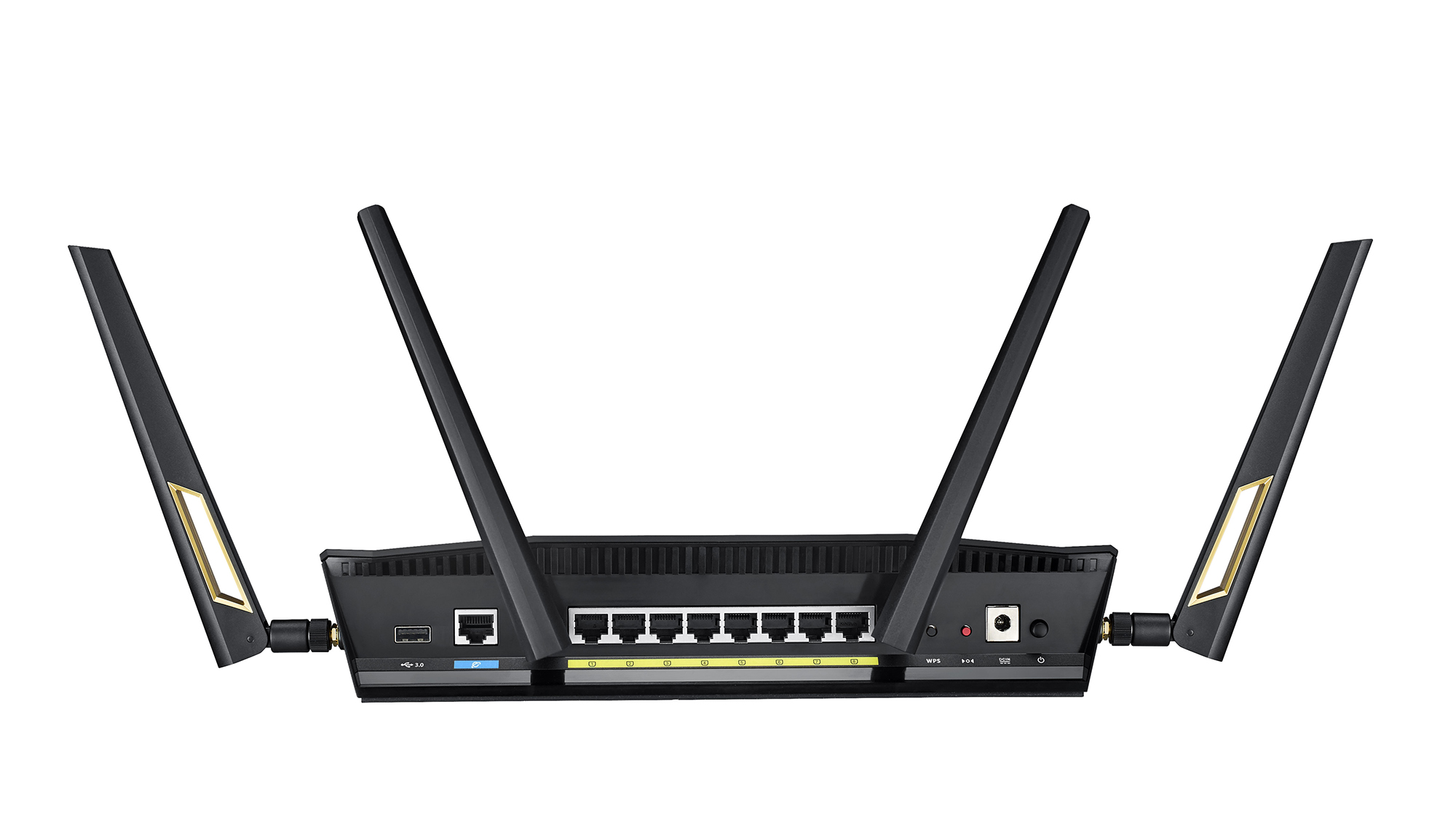Asus RT-AX88U review: The next step in Wi-Fi technology
Wi-Fi 6 finally hits the mainstream, and it’s as fantastic as it is expensive


It's expensive, but Asus' luxurious gold-trimmed router shows off the astonishing potential of Wi-Fi 6. If you want to experience the future of wireless technology, this is it.
-
+
Outstanding speed and range; Good selection of additional features; Free security and VPN services
-
-
Expensive; Clunky web management console

The new wireless standard is here: 802.11ax, also known as Wi-Fi 6, is designed to deliver much faster connections than 802.11ac, and to keep things moving more smoothly when lots of devices want to connect at once.
The RT-AX88U has the familiar look of a high-end Asus router and offers all the features you'd expect. What it doesn't offer is the 11Gbits/sec of triple-band Wi-Fi 6 routers, including Asus' own bigger, jazzier ROG Rapture GT-AX11000. Instead it makes do with a mere 6Gbits/sec, with Asus saving some pennies by including two radios rather than three. This is less of a concern than it was with 802.11ac: the new standard uses a technical trick called orthogonal frequency-division multiple access to achieve better performance when multiple devices are connected, so there's less to be gained by spreading the load across two radios.
Asus RT-AX88U review: Performance
The major defining feature of 802.11ax is that it encodes more information into each packet of transmitted data than previous wireless standards. So, even though the RT-AX88U's twin radios use the same frequencies as an 802.11ac router, they're able to deliver significantly higher bandwidth: the 2.4GHz radio can handle speeds of up to 1,148Mbits/sec and the 5GHz radio is rated at a super-fast 4,804Mbits/sec.
On top of this, the standard uses new techniques to reduce the impact of interference, so less of that bandwidth is lost to environmental factors. Asus claims with unusual specificity that, as a result of these improvements, the AX88U delivers 2.3 times the performance of a comparable 802.11ac router.
To find out how true that is, we tested the AX88U with our usual methods, by installing the router with default settings then walking around our test premises with a Dell Latitude 5490 laptop (equipped with a 2x2 MIMO Intel AX200 802.11ax adapter and connected on the 5GHz band) and copying large files to and from a NAS appliance connected directly to the router via Ethernet.

In the tables below, you can see the speeds we measured in various rooms, in megabytes per second, stacked up for comparison against one of the fastest 802.11ac routers on the market, the 440 Netgear Nighthawk Pro Gaming XR700.
| Row 0 - Cell 0 | XR700 upload | RT-AX88U upload | XR700 download | RT-AX88U download |
| Room one | 10.9MB/sec | 39.7MB/sec | 32.6MB/sec | 70.5MB/sec |
| Room two | 4.2MB/sec | 27.8MB/sec | 19.3MB/sec | 56.8MB/sec |
| Room three | 2.4MB/sec | 16.6MB/sec | 18.4MB/sec | 32.6MB/sec |
| Rear terrace | 3.9MB/sec | 24.7MB/sec | 19.4MB/sec | 51.6MB/sec |
Your eyes do not deceive you. The RT-AX88U roughly doubled our download speeds compared to the XR700, and write speeds in many areas of the house were more than six times as fast. To reiterate, these numbers are in megabytes per second, so even at the opposite end of the building to the router, the connection is strong enough to max out a 250Mbits/sec fibre internet connection. Considering the number of walls and appliances in the way, not to mention the plumbing, that's amazing.
Of course, it will be a few years before all our clients support Wi-Fi 6 -- right now, the most popular device that supports it is probably the Samsung Galaxy S10 -- so for the time being the RT-AX88U's 802.11ac performance remains very relevant as well. To measure this, we repeated the test using a Surface Laptop, with its integrated 2x2 MIMO Marvell Avastar-AC adapter. Here are the results, again compared to the XR700:
| Row 0 - Cell 0 | XR700 upload | AX88U upload | XR700 download | AX88U download |
| Room one | 10.9MB/sec | 17.8MB/sec | 32.6MB/sec | 32.2MB/sec |
| Room two | 4.2MB/sec | 7.8MB/sec | 19.3MB/sec | 16.9MB/sec |
| Room three | 2.4MB/sec | 5MB/sec | 18.4MB/sec | 10.8MB/sec |
| Rear terrace | 3.9MB/sec | 4.2MB/sec | 19.4MB/sec | 8MB/sec |
In this mode, the RT-AX88U can't quite keep up with the very fastest 802.11ac router there is but these are still very respectable speeds. There's more than enough bandwidth here to watch Netflix in 4K on our laptop while we're out on the rear terrace and, frankly, it's hard to see what more you could ask for. And since the RT-AX88U supports 4x4 MU-MIMO, the connection shouldn't stutter if other systems in the house start demanding network access at the same time, although a tri-band model would be able to handle even more clients at once.

Finally, let's look at 2.4GHz performance. This radio band is better able to penetrate through physical obstacles, but it has a lower data rate and a greater susceptibility to interference, so you're almost always better off with a 5GHz connection. For the record, though, here are the speeds we saw over the 2.4GHz band, in both 802.11ac and 802.11ax modes (on the RT-AX88U only):
| Row 0 - Cell 0 | 802.11ac upload | 802.11ax upload | 802.11ac download | 802.11ax download |
| Room one | 5.9MB/sec | 11.8MB/sec | 8.5MB/sec | 19.3MB/sec |
| Room two | 3.9MB/sec | 8.5MB/sec | 6.9MB/sec | 12.8MB/sec |
| Room three | 3.4MB/sec | 6.4MB/sec | 5.6MB/sec | 9.2MB/sec |
| Rear terrace | 2MB/sec | 6.7MB/sec | 5.5MB/sec | 11.1MB/sec |
As you can see, 802.11ax once again provides a decent speed boost -- although it's hard to imagine a situation where you'd have the option of using 802.11ax but not on the 5GHz band.
Asus RT-AX88U review: Design
The RT-AX88U is tastefully designed, with few of the attention-seeking trappings of Asus' more ostentatious gaming routers. Only the gold-lined cut-outs on the four antennae hint that there's anything special about this router.
Functionally, though, it's pretty upmarket. There are eight Gigabit Ethernet ports and, while the AX88U doesn't have a 2.5GbE socket like the ROG Rapture, the first two ports support 802.3ad link aggregation. Interestingly, you can also combine LAN port 4 with the WAN port to support a 2Gbits/sec internet connection, not that many of us will be able to take advantage of that.

There's also a USB-A 3.1 socket at the rear, and another tucked away behind a flap at the front. Plug in a flash drive or hard disk and the RT-AX88U can serve as a basic NAS, with support for multiple user accounts and macOS Time Machine backups. The second port can be used to share a USB printer or plug in a 4G modem to serve as failover if your main internet connection goes down.
Other highlights include a built-in VPN server (supporting PPTP, OpenVPN and IPSec), to let you securely access your network over an untrusted internet connection; integration with Alexa and IFTTT to automate basic tasks; and Asus' nifty AiMesh system, which lets you extend your Wi-Fi coverage by linking two or more Asus routers together into a mesh network. If you're currently using an older Asus router, this could give it a useful second life once you upgrade to the RT-AX88U.
You also get a single-device account on the WTFast VPN, which is designed to minimise lag in online games, plus the AiProtection system powered by Trend Micro, which provides a variety of intrusion-protection and antivirus features. Both are free forever; a welcome reassurance in an age when every service seems to be trying to drag you into a paid subscription.
If we've one grumble, it's that the web-based management interface is exactly the same as on every Asus router since 2012, and frankly it's a bit of a mess, with nested tabs, panes and buttons that can make it fiddly to find what you're looking for. A slick router like this deserves a front end to match. Still, after the initial set up you should only need to deal with it once in a blue moon.
Asus RT-AX88U review: Verdict
We knew that 802.11ax would mean faster Wi-Fi, but the reality is better than we'd dared hope for. Not only is it massively faster than 802.11ac at short range, it maintains that huge advantage through obstacles and over long distances. Hitherto we've been using a mesh Wi-Fi system to ensure we get decent coverage throughout our premises but with Wi-Fi 6 it's simply not necessary. Perhaps it's an exaggeration to say that 802.11ax changes everything but it does overturn the established wisdom of what you can expect from a wireless connection.
Of course, the RT-AX88U isn't the only way to get 802.11ax. Other products are starting to trickle onto the market, and by Christmas every major router brand will doubtless have multiple Wi-Fi 6 offerings, including some at much lower price points. If you want to make the leap right now, however, you won't regret it: this superb router is fast, functional and decisively future-proof.
Verdict
It's expensive, but Asus' luxurious gold-trimmed router shows off the astonishing potential of Wi-Fi 6. If you want to experience the future of wireless technology, this is it.
Dual-band 802.11ax 2.4GHz/5GHz Wi-Fi router 1,1148Mbits/sec on 2.4GHz 4,804Mbits/sec on 5GHz Quad-core 1.8GHz processor 4 x external antennae 8 x Gigabit Ethernet 2 x USB-A 3.1 300 x 188 x 61mm (WDH) 1.01kg 1yr warranty
Get the ITPro daily newsletter
Sign up today and you will receive a free copy of our Future Focus 2025 report - the leading guidance on AI, cybersecurity and other IT challenges as per 700+ senior executives
Darien began his IT career in the 1990s as a systems engineer, later becoming an IT project manager. His formative experiences included upgrading a major multinational from token-ring networking to Ethernet, and migrating a travelling sales force from Windows 3.1 to Windows 95.
He subsequently spent some years acting as a one-man IT department for a small publishing company, before moving into journalism himself. He is now a regular contributor to IT Pro, specialising in networking and security, and serves as associate editor of PC Pro magazine with particular responsibility for business reviews and features.
You can email Darien at darien@pcpro.co.uk, or follow him on Twitter at @dariengs.
-
 ‘Phishing kits are a force multiplier': Cheap cyber crime kits can be bought on the dark web for less than $25 – and experts warn it’s lowering the barrier of entry for amateur hackers
‘Phishing kits are a force multiplier': Cheap cyber crime kits can be bought on the dark web for less than $25 – and experts warn it’s lowering the barrier of entry for amateur hackersNews Research from NordVPN shows phishing kits are now widely available on the dark web and via messaging apps like Telegram, and are often selling for less than $25.
By Emma Woollacott Published
-
 Redis unveils new tools for developers working on AI applications
Redis unveils new tools for developers working on AI applicationsNews Redis has announced new tools aimed at making it easier for AI developers to build applications and optimize large language model (LLM) outputs.
By Ross Kelly Published
-
 Google layoffs continue with "hundreds" cut from Chrome, Android, and Pixel teams
Google layoffs continue with "hundreds" cut from Chrome, Android, and Pixel teamsNews The tech giant's efficiency drive enters a third year with devices teams the latest target
By Bobby Hellard Published